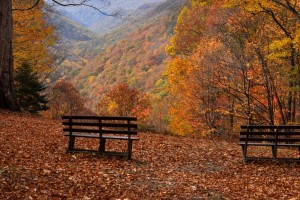Get to Know the Trees that Make Up Southern West Virginia’s Fall Palate
It’s a beautiful sight to peer out across the West Virginia mountains and take in the wonderful colors that fall brings. So many hues of red, yellow, and orange dot the landscape when the leaves are in peak foliage.
The forests of West Virginia have lots of different hardwood tree species, making our area a wonderful place to leaf peep. Do you ever wonder what types of trees give us each of those amazing colors? Here’s the lowdown on which trees are responsible for the different colors that make up the fall palette.
The Reds
One of the most striking colors of fall foliage is red. The blazing display created by red leaves helps enhance all of the other colors. One reason red is such a dominant color in our fall forests is the predominance of the Red Maple tree. This species is one of the most abundant trees in the eastern US, and its scarlet red leaves make for spectacular fall viewing.
Another tree that contributes red to the autumn spectrum is the Oak tree. There are a few different species of oak whose leaves will turn red. These include the Northern Red Oak, the Pin Oak, the Scarlet Oak and the Swamp Chestnut oak. These trees all turn a dark crimson or rusty red in color. They all grow very tall, so their leaves are prevalently seen in the canopy.
The other species that add red hues to the autumn mountains are the Dogwood, the Sourwood, the Black Gum and the Sumac.
The Yellows
Yellow leaves provide a great contrast to the bright reds and crimsons that our forests display. There are a great many species of tree that produce yellow leaves in the fall, but the biggest contribution here comes from the Hickory family. The Pignut Hickory, the Shagbark Hickory, the Shellbark Hickory, and the Mockernut Hickory all produce dull yellow or brownish-yellow leaves when they turn.
Another family that gives us yellow in the fall are the Birch trees. Both the River Birch and the Sweet Birch dot the forest with yellow pigment, although the dull yellow of the River Birch will be more noticeable down lower in the valleys.
Walnut trees, including the Black and White Walnut and the White Ash, the American Elm, the Silver Maple, the Black Locust, and the Beech trees all contribute their shades of yellow to the painted autumn hills here in West Virginia.
The Changers
Some tree species give us multiple colors as they go through their fall ritual of losing leaves. They may start off one color, and then as the process goes on, may turn one or two more colors before they are through.
One of the main species that we see producing multiple colors here is the Sugar Maple. Their leaves can turn from yellow to orange, and then to a red before they drop them altogether. Sassafras is another species that will display red, orange, and yellow in its autumn ritual.
White Oak trees, which are another dominant species of our forests, will display pink or red leaves. Witch Hazel will turn from a bright yellow to a deep orange, and Sweetgum will go from yellow to orange to brown.
Leaf peeping in the fall is a wonderful way to spend a day. And now you know what trees are responsible for all that beautiful color.
Where’s your favorite place to see changing leaves in the fall?

